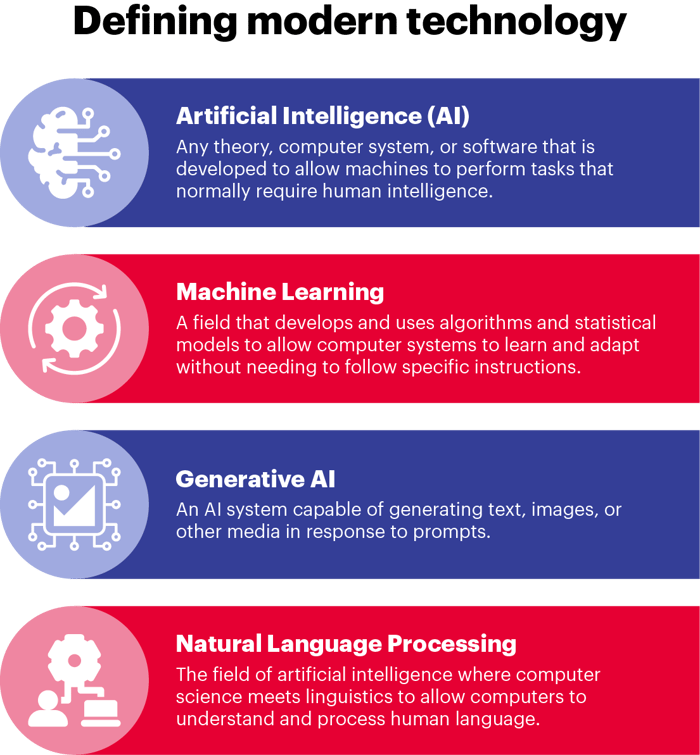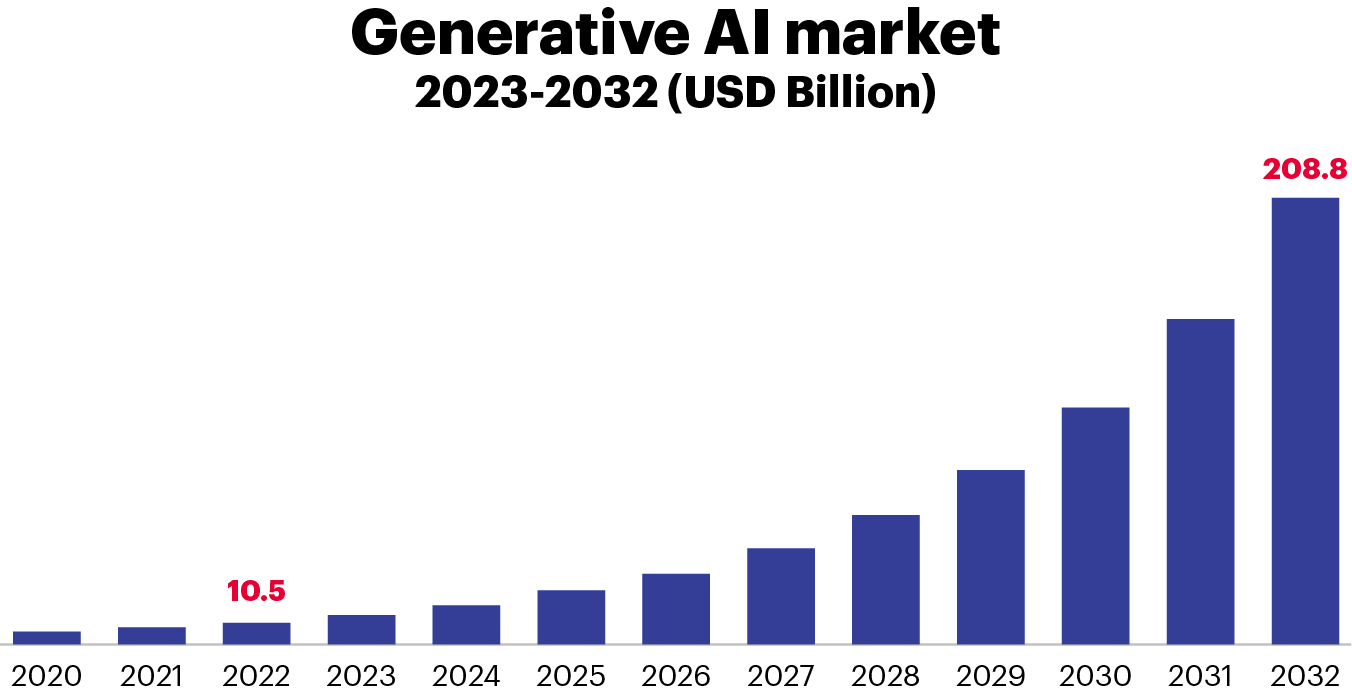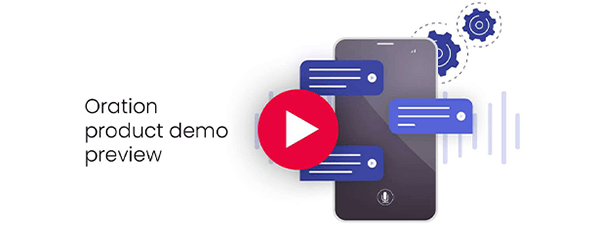In an industry where innovation is the name of the game, it would be easy for outsiders to assume the likes of software developers, computer engineers and other technology types become immune to hype. It seems every week there is a new ‘game changer’ and the next transformative technology is only a headline away. Staying abreast of ‘the next big thing’ is imperative but so too is not being bedazzled by it.
That said, every now and then a technological revolution comes along that can’t be ignored and today that is generative AI. While the artificial intelligence model can trace its origins to the 1960s1, the past year has seen a boom in solutions that showcase its incredible ability to generate text, images or other content based on the data it is trained on. From ChatGPT attracting an amazing 1 million users in only five days2 to the likes of GitHub Copilot and Stable Diffusion wowing their audiences, it is no surprise countless organisations are rushing to incorporate the technology into their own operations.
This is supported by an Acumen Research and Consulting study that has projected the global generative AI market will soar from US$10.5 billion in 2022 to a jaw-dropping US$208.8 billion by 20323. A deeper dive into such numbers reveals:
- Generative audio tools were expected to attract more than 100,000 developers by the end of 20234;
- 30% of outbound messages from large organisations will be synthetically generated by 2025, up from less than 2% in 20225;
- Generative AI will account for 10% of all data produced by 2025, up from less than 1% in 20216; and
- 60% of data used for the development of AI and analytics projects will be synthetically generated by 20247.

Introducing the Generative AI Assistant
Oration by Convai is the go-to plugin for organisations that want to optimise performance in their contact centres. An easy-to-implement, low-cost, cloud-based solution, it can deflect calls, identify callers, determine intent and ultimately do what Convai has been doing for more than 20 years – enable better conversations by using conversational AI.
One of the joys of Oration is its simplicity - a user-friendly interface that requires no technical experience or expertise and the capability for the solution to be operational within days. Creating exceptional CX lies at the heart of modern contact centres, not to mention the business imperatives of increasing efficiencies and reducing costs.
Oration by Convai ticks all these boxes and now, thanks to the vision of its creators, comes the Generative AI Assistant.
The origins of Generative AI Assistant
Having conducted about 40 large-scale deployments in recent years, the Oration team has dramatically reduced time to implementation but there is no doubt that initial set-up remains a significant investment. With that in mind, Convai’s developers were driven to see how generative AI could play a role in reducing that load.
An initial theory was to use the technology to respond directly to customer queries but that is a step too at present. Accuracy is paramount in any customer-facing setting and, as other developers have found, it is incredibly difficult to place watertight guardrails around generative AI. With a mere 1-2% of incorrect responses enough to cause brand damage, the risks clearly outweigh the rewards.
Given that, Convai’s focus turned to creating a generative AI solution that combines the best of the technology with human oversight. Integrity of information is crucial in the contact centre world and Generative AI Assistant ensures that remains the case for Oration.
How Generative AI Assistant works
When developing a ‘caller experience’ inside Oration, users are greeted by links to functions such as Welcome, Main Intent and Transfer. A key part of creating a customer interaction stems around the Main Intent function and working out what callers are going to say and ensuring the system knows what to do when they say it.
That is done by using two critical functions – Intents and Responses.
The Intents is where a user inputs the topics that callers might reference. Depending on the sector in which the contact centre operates, there are countless reasons for making a call – along with countless ways of saying them, which must also be factored into the Intents function.
Manually inputting individual intents is a time-consuming process and extremely difficult to ensure all bases are covered. Imagine sitting down with every contact centre agent and asking why people call them. Despite one’s best efforts, they may only capture 50% of the reasons, let alone the different ways callers explain what they want. The only guarantee is no guaranteed coverage of all topics.
Enter Generative AI Assistant.
Instead of manually inputting Intents, users have the option of clicking ‘Add Suggested Intents’ where they only need to input their ‘Company Name’ and ‘Location’ for generative AI to weave its magic. In a matter of moments, the solution starts listing reasons someone may reach out to that contact centre.
Take the example of ‘Brisbane City Council’. Within seconds, Generative AI Assistant will populate the Intent function with the likes of ‘Animal Control’, ‘Building Permits’ and ‘Community Events’, reason after reason that someone may phone a council contact centre. An added layer then allows a user to click on an individual Intent (eg: Animal Control) and review a list of how a caller might reference that topic (eg: barking dogs, dangerous animals, stray animals).
It is then a simple matter of checking tick boxes for the suggested intents to be used in the system and clicking ‘Add Suggested Intents’. Want more intents? Simply click ‘Search for more’ and Generative AI Assistant will do just that, providing list after list of related topics until a user is satisfied they have enough to go live.

Source: Generative AI Market Size, Share, Trends | Forecast 2032 (acumenresearchandconsulting.com)
Benefits of Generative AI Assistant
Optimal priming – priming a call router manually is a time-consuming and often tedious process that requires specific knowledge of an organisation and its services. Generative AI Assistant turns that into a fast and seamless endeavour that removes the need for domain expertise.
- Data privacy: Oration’s incredible new feature does not require access to an organisation’s knowledge bases and internal databases to work its magic. As a completely free-running solution, Generative AI Assistant taps into publicly available information as per a standard generative engine.
- Non-technical: Oration takes pride in its reputation for being incredibly easy to use and Generative AI assistant continues that tradition. There is no need for users to be tech wizards or employ an entire IT team. Like all aspects of Oration, the focus is on creating a platform that wows people with its simplicity rather than striking fear into them.
- Going the extra mile: anyone who has manually populated intents knows there comes a stage where enough is enough. Not Generative AI Assistant. At the click of a button, it will continue to deliver reasons that customers may call including those that are out of the box (eg: ‘graffiti removal’ for a council organisation). Only one caller in 10,000 may raise such an issue but Generative AI Assistant can help ensure it is ready to be addressed.
Summary
This is just the beginning for Generative AI Assistant. In its first iteration, it is allowing organisations to instantly focus on reviewing Intents and Responses rather than spending hours on the laborious process of creating them. Better still, as more metadata comes online, the solution will only become bigger and better and the Convai team is already looking ahead to how it will be able to expand the concept to deliver even more benefits such as the generation of meaningful FAQs.
In the meantime, there is a lot to like about an AI-powered helper that speeds up the creation of intents and reduces the need for users to have domain knowledge. It’s almost hard to believe that someone could create a complete contact centre call router in less than an hour with minimal subject expertise about an organisation.
But that’s the exciting thing about Generative AI Assistant – it’s making the unbelievable a reality.
References
1. What is Generative AI? Everything You Need to Know (techtarget.com)
2. ChatGPT hit 1 million users in 5 days: Here’s how long it took others to reach that milestone | Technology News - The Indian Express
3. Generative AI Market Size, Share, Trends | Forecast 2032 (acumenresearchandconsulting.com)
4. State of AI Report 2022 - ONLINE - Google Slides
5. Generative AI Use Cases for Industries and Enterprises (gartner.com)
6. Gartner Identifies the Top Strategic Technology Trends for 2022
7. Gartner Business Insights, Strategies & Trends For Executives







